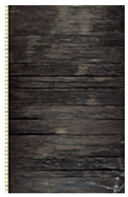Abstract
The lithofacies characteristics of the Qingshankou Formation (K2qn) shale in the Gulong Depression are crucial for oil exploration and development. This study investigates the K2qn shale lithofacies characteristics and their impact on reservoir physical properties using scanning electron microscopy (SEM), high-pressure mercury injection (HPMI), and logging quantification. The results indicate that the main minerals in K2qn shale are quartz, plagioclase, and clay. The sedimentary structures are classified into three types: laminated, layered, and massive. The K2qn shale lithofacies can be categorized into 12 types based on a combination of lithology and sedimentary structure. The main types are laminated clayey shale, layered clayey shale, and layered felsic shale. The larger the average pore size of the K2qn lithofacies, the stronger the heterogeneity of pore size distribution in space and the better the pore-to-throat connectivity. The impact of K2qn shale lithofacies on reservoir physical properties is mainly due to differences in lithology, complemented by variations in the sedimentary structural model. Under certain diagenetic or tectonic conditions, a layered sedimentary structural model of lithofacies may not increase reservoir permeability. Generally, felsic and carbonate rocks in tidal flat environments promote the development of shale with high permeability and porosity, while lithofacies deposited in static water environments below the wave base in lake basins typically exhibit low permeability and porosity. The physical properties of a reservoir are primarily influenced by the differences in pore throat characteristics resulting from variations in lithology.
1. Introduction
Lithofacies, as the main component of sedimentary facies, is a combination of rocks or rock types that are formed under specific sedimentary environments [1,2,3]. Lithofacies characteristics vary with time and space, and changes in the same rock layer in the horizontal direction reflect differences in sedimentary environments in different regions during the same period, while changes in the vertical direction reflect changes in sedimentary environments in the same region over different periods [1,2,3]. Certain lithofacies are necessary conditions for reservoir development, and differences in lithofacies represent the impact of sedimentary environments on reservoir physical properties. It can be said that the vertical and horizontal distribution characteristics of lithofacies control oil and gas migration and accumulation [1,2,3,4,5].
Currently, global exploration and development of unconventional oil and gas have become a hot topic. Many scholars have conducted in-depth research on the sedimentary environment, formation mode, type characteristics, and characterization methods of shale reservoir lithofacies, and achieved numerous results [2,3,4,5,6,7]. Xu Minghui et al. took the Chang 7 section of the Ordos Basin as an example to study the classification scheme of lacustrine organic-rich mud shale lithofacies and sedimentary environmental characteristics [8]. Zhu Haihua et al. evaluated the relationship between the sedimentary environment and source-reservoir characteristics of the Da’anzhai section of the lower Jurassic system in Northeast Sichuan [9]. He Xiaobiao et al. analyzed the differences in pore characteristics and their influencing mechanisms between different lithofacies types of continental shale through core experiments [10]. At the same time, it has been proven that, under the same fracturing conditions, there are significant differences in production capacity between different shale lithofacies sections. Therefore, as an important factor controlling shale reservoir physical properties and oil content, lithofacies is an indispensable part of exploring advantageous reservoir characteristics. The classification of reservoir lithofacies types and the study of their impact on reservoir physical properties are fundamental for oil and gas exploration and development, and have important theoretical and practical significance [11,12,13,14]. However, current research on the impact of shale lithofacies characteristics on reservoir physical properties is limited, which correspondingly hampers the exploration and development of shale oil and gas.
In recent years, a large amount of shale oil and gas resources have been discovered in the Qingshankou Formation (K2qn) of the Gulong Depression in the Songliao Basin. The K2qn shale reservoirs have tremendous potential for increasing reserves and production, and have become a key area for oil and gas exploration and development in the Songliao Basin [2,3,4,5]. Studies have shown that the Gulong Depression is a deep lake sedimentary environment with characteristics of a typical lacustrine shale sedimentary system [2,3,4]. Currently, the classification of K2qn shale is mainly based on the combination characteristics of lithology and structure. For reservoirs with a simple lithology or structure, the classification of lithofacies is relatively simple, and its impact on reservoir physical properties is not complex. However, with the continuous deepening of exploration and development of the K2qn shale, it has been found that, due to the diverse mineral types and complex sedimentary structures of the reservoirs, new challenges have emerged with multiple lithofacies types, difficult characterizations, and inaccurate evaluations of reservoir effectiveness [1,2,3,4,5,6,7]. It can be said that research on lithofacies characteristics and their impact on the reservoir physical properties in the K2qn shale is necessary.
2. Geological Background and Methods
Located in the central Songliao Basin, the Gulong Depression is characterized by a sedimentary environment that ranges from deep lake to semi-deep lake facies. During the Late Cretaceous, two significant lake transgressions occurred in the Nenjiang and Qingshankou Formations, resulting in two distinct sets of deep lake to semi-deep lake mud shale facies that serve as rich source rocks for shale oil. During the K2qn forming, the lake level rapidly rose, and the influx of seawater brought nutrients such as phosphorus and sulfur into the basin, leading to eutrophication. This environment allowed for extensive algal growth in the lake, while the lake bottom remained undisturbed. Additionally, the strong expansion of the basin prevented terrestrial debris from entering the lakes, creating a reducing and stable environment in the basin’s center. Sediments in this region primarily consisted of clay and suspended organic matter, leading to a widespread distribution of organic-rich mud shales—considered to be crucial hydrocarbon source rock layers within this basin [1,3].
A total of 15 core samples of shale rocks (2.5 cm in diameter and 5.0 cm in length) obtained from K2qn shale reservoirs were tested by the mercury pressure. The high-pressure mercury injection (HPMI) tests were performed using an American Instruments Auto-pore IV 9520 mercury pressure test instrument with a maximum test pressure of 413 MPa (60,000 Psi) and a pore size test range from 800 μm to 3 nm. Prior to the high-pressure mercury tests, the surface of 1 cm3 shale oil samples was first polished, and the samples were then placed in a drying oven at 60 °C for about 48 h to remove volatilized compounds, and then cooled in the drying oven to room temperature. The tests were conducted at National Key Laboratory of Petroleum Resources and Engineering, China University of Petroleum (Beijing).
Litho scanner logging can meet the needs of calculating clay mineral content and identifying lithology. It uses a neutron generator; the measuring range is 1~10 MeV, and the vertical resolution is 45.72 cm. This well logging data output 18 elements, including Al, Ba, C, Ca, Cl, Cu, Fe, Gd, H, K, Mg, Na, Ni, O, S, and Ti. [7]. Imaging logging is to convert the changes in resistivity and acoustic impedance caused by the changes in formation lithology, physical properties, fractures, holes, bedding and other formation characteristics into the display of different colors and forms on the image [7].
3. Results
3.1. Lithology and Sedimentary Structure
The mineral composition of the K2qn shale mainly consists of quartz (19–43%, average of 34%), plagioclase (8–65%, average of 31%), and clay minerals (2–52%, average of 23%). There are also trace amounts of potassium feldspar, calcite, dolomite, and pyrite. The clay minerals are dominated by illite, followed by illite/montmorillonite mixed layer and kaolinite. Carbonate minerals are concentrated in the ostracod limestone (total rock content is greater than 30%, and most of them are greater than 50%), and calcite cement can be seen in the silty laminae of silty sandstone and mudstone filled with clastic particles (total rock content is 2–20%, with an average of 9%). Based on the content of "clay minerals-carbonate minerals-clastic fractions (felsic/siliciclastic)", the K2qn shale can be classified into four types: (1) ostracod limestone, (2) clayey shale, (3) felsic shale, and (4) dolomitic shale (Table 1).

Table 1.
Lithologic classification of K2qn shale in the Gulong Depression.
Through the optimization calculation method of litho scanner logging, the longitudinal continuous quantitative characterization of mineral composition was achieved. The results show that the variation of lithology and lithofacies in the K2qn shale reservoir of the Gulong Depression is rapid in the vertical direction, and the heterogeneity of the reservoir is strong, mainly consisting of felsic shale and ostracod limestone (Figure 1). Regarding clayey shale, conventional logging shows a high gamma value (GR), a low density (DEN), and a high acoustic travel time (AC). Litho scanner logging shows low Mg and Ca values, high clay mineral content, relatively low felsic content, and low carbonate mineral content. Imaging logging shows a banded pattern, and stratification can be seen where lamina developed. Regarding felsic shale, conventional logging shows a low density (DEN), a low acoustic travel time (AC), and low neutron (CNL). Litho scanner logging shows high Ca and Mg values and high iron dolomite content. Imaging logging shows a blocky, linear, or banded pattern. Regarding ostracod limestone, conventional logging shows a high gamma value (GR), high resistivity (RMSL), a high density (DEN), and a low acoustic travel time (AC). Litho scanner logging shows a high Ca value and high calcite content. Imaging logging shows a bright blocky or banded pattern. Regarding dolomitic shale, conventional logging shows a low density (DEN) and an acoustic (AC) lag. The imaging logging results show that the Ca and Mg values are high, and the content of ferrodolomite is high. The imaging logs show blocky, linear, or banded patterns (Figure 2).
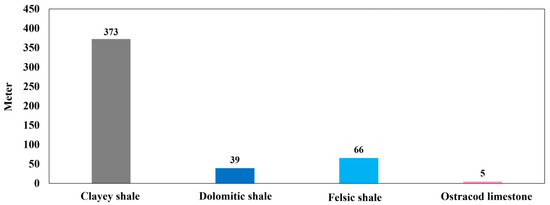
Figure 1.
Lithologic thickness ratio of K2qn shale in the Gulong Depression.
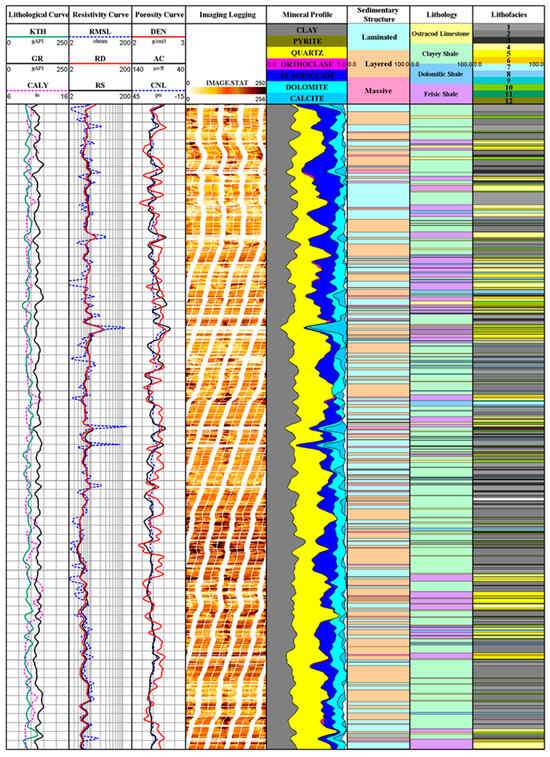
Figure 2.
Quantitative identification of longitudinal lithology, sedimentary structure, and lithofacies of Gulong shale in the single well. (Note: 1. laminated dolomitic shale facies; 2. laminated ostracod limestone facies; 3. laminated felsic shale facies; 4. laminated clayey shale facies; 5. layered dolomitic shale facies; 6. layered ostracod limestone facies; 7. layered felsic shale facies; 8. layered clayey shale facies; 9. massive dolomitic shale facies; 10. massive ostracod limestone facies; 11. massive felsic shale facies; 12. massive clayey shale facies).
The sedimentary structure types of K2qn shale are massive, layered, and laminated (Figure 3). Among them, a large number of dense clay and organic layers can be seen in the laminated shale core, with a single layer thickness of millimeter (less than 1 cm), and the layer density ranges from 157/m to 400/m. In layered shale cores, there are frequent interlayers of dolomitic and muddy bands, and the thickness of a single band is centimeter (1–10 cm). Thin layer density ranges from 9 strips/m to 98 strips/m. The massive shale core structure is almost undeveloped, the stratification and banding are not developed, the lithology is single, the thickness of the single layer is decimeter level (greater than 10 cm), and the thickness of the block ranges from about 0.1 m to 0.75 m. According to the identification and division of single well sedimentary structure types, whether it is based on the number of layers or the thickness, K2qn shale sedimentary structure types are mainly layered, followed by laminated, and the massive development frequency is the lowest (Figure 4). Among them, the imaging logging of clayey shale shows a banded pattern, and stratification can be seen at the development of lamination. For the characteristics of imaging logging, the felsic shale shows blocky, linear, or banded patterns, the ostracod limestone shows a bright block or banded pattern, and the dolomitic shale shows blocky, linear, or banded patterns (Figure 2).

Figure 3.
Sedimentary structure types of Gulong shale.
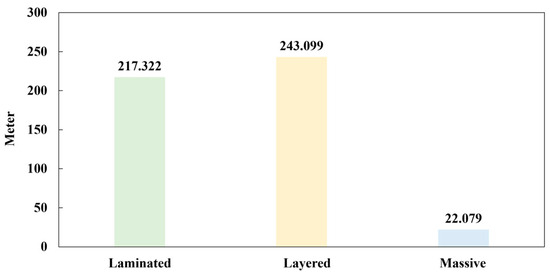
Figure 4.
Thickness distribution characteristics of different types of sedimentary structures in Gulong shale.
3.2. Lithofacies Types
Lithofacies division not only considers the lithology characteristics but also the rock structure model and its combination characteristics. It is more conducive to improving the geological prediction ability of lithofacies research. Considering the diverse types of sedimentary structure and lithology combination of K2qn shale, the lithofacies can be classified into 12 types: (1) laminated dolomitic shale facies, (2) laminated ostracod limestone facies, (3) laminated felsic shale facies, (4) laminated clayey shale facies, (5) layered dolomitic shale facies, (6) layered ostracod limestone facies, (7) layered felsic shale facies, (8) layered clayey shale facies, (9) massive dolomitic shale facies, (10) massive ostracod limestone facies, (11) massive felsic shale facies, and (12) massive clayey shale facies.
Based on the analyzed target layer of a typical well in the study area, the lithofacies are mostly clayey and felsic, whereas the contents of the dolomitic lithology and ostracod limestone phase are very small (Figure 2). This is mainly due to the fact that K2qn shale is generally in a deep lacustrine to semi-deep lacustrine sedimentary environment, and the terrigenous clastic supply is relatively insufficient [1,2,3], so the lithofacies dominated by felsic shale is rarely developed. At the same time, because the deposition period of K2qn shale is only a short shoreline shallow lake period, the overall size of the ostracod limestone facies is very small, and the content proportion is low.
3.3. Pore Types
According to the genesis of pore types [15], the pore types of K2qn shale can be divided into intergranular pores and intergranular pores. The intergranular pores of the target layer in the study area are mainly primary pores, and some are secondary pores. Intergranular pores are mainly developed in micrite clay minerals, and both nanoscale and micron-scale clay minerals are developed. Meanwhile, the pore size of organic intergranular pores is small, and most of them are nano-scale (Figure 5a,b). Due to the high content of clay minerals in the study area, the intergranular pores are the basic pores in the study area, which are often developed in large quantities in the clayey shale phase, which can make up for the defect of a small pore size to a certain extent and provide a certain reservoir space.
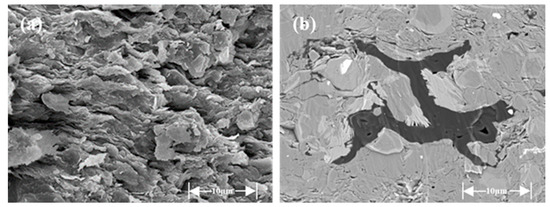
Figure 5.
Characteristics of intergranular pores in Gulong shale ((a) clay minerals intergranular pore; (b) organic pore).
The intergranular pores of K2qn shale are mostly primary pores, elliptical or irregular. K2qn shale is in the early to middle diagenetic stage, and the reservoir has undergone relatively strong compaction transformation [8,16,17]. Well-preserved intergranular pores are less developed, terrigenous clastic particles are small in size, and the pore radius is mostly nanometer (Figure 6). At the same time, for felsic shale facies with high terrigenous debris content, the intergranular pores are mostly micron in size (Figure 6), but when the interior is filled with clay minerals, the secondary intergranular pores with a small pore size and poor connectivity are formed (Figure 6). In general, intergranular pore connectivity is good, but the development degree is low in the study area, while the intergranular pore is widely developed with a small pore size and poor connectivity.

Figure 6.
Characteristics of intergranular pore in Gulong shale ((a) felsic lamination; (b) interfeldspar pore; (c) intergranular pore filled with clay minerals).
3.4. Pore Size and Distribution
The high-pressure mercury injection curves of K2qn shale can be divided into three types. The maximum mercury saturation of the Type 1 mercury injection curve is between 70% and 90%, the mercury injection curve platform is obvious, the slope is large, and the pore throat connectivity is good (Figure 7a). The pore size was mainly between 0.002 and 1 μm, and the average pore size was 0.761 μm (Figure 7b). The corresponding lithofacies are as follows: laminated dolomitic shale facies, layered dolomitic shale facies, laminated felsic shale facies, layered felsic shale facies, and massive felsic shale facies. Compared with the Type 1 mercury injection curve, the maximum mercury injection saturation of Type 2 is similar, ranging from 70% to 90%. The mercury injection curve plateau is obvious, but the slope is reduced, while the pore throat connectivity is general (Figure 7c). The pore size was mainly between 0.002 and 0.07 μm, and the average pore size was 0.012 μm (Figure 7d). The corresponding lithofacies are as follows: massive felsic shale facies, massive dolomitic shale facies, laminated clayey shale facies, layered clayey shale facies, and layered ostracod limestone facies. The maximum mercury saturation of Type 3 is much smaller than that of Type 1 and 2, ranging only from 30% to 60%. The mercury inlet curves have obvious platforms but small inclines, as well as poor pore throat connectivity (Figure 7e). The pore size was mainly concentrated in the range of 0.006~0.04 μm with an average of 0.009 μm (Figure 7f). The corresponding lithofacies are as follows: laminated ostracod limestone facies, layered ostracod limestone facies, massive ostracod limestone facies, and massive clayey shale facies.
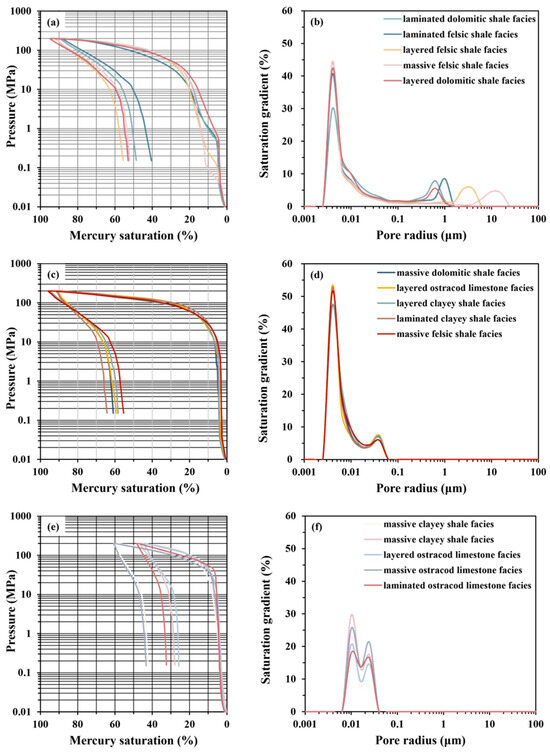
Figure 7.
The mercury injection curves and characteristic of their pore radius of K2qn formation in the Gulong Depression. ((a,c,e) mercury injection and removal curves of different facies; (b,d,f) pore size distribution of different facies).
The pore size distribution of reservoir spaces and fluid dominant migration channels of different K2qn shale lithofacies show significant differences. The fluid dominant migration channel size of the laminated dolomitic shale facies, layered dolomitic shale facies, laminated felsic shale facies, layered felsic shale facies, and massive felsic shale facies is generally 100 nm (Figure 7a,b). The massive felsic shale facies, massive dolomitic shale facies, laminated clayey shale facies, layered clayey shale facies, and layered ostracod limestone facies have the fluid dominant migration channels with 40 nm (Figure 7c,d). Meanwhile, the laminated ostracod limestone facies, layered ostracod limestone facies, massive ostracod limestone facies, and massive clayey shale facies is only 20 nm (Figure 7e,f). It can be said that the characteristics of the fluid dominant migration channels in K2qn shale depend on the lithofacies types.
In addition, when using the aspect ratio to characterize pore types, a value of 1 approximately represents spherical pores, a value of less than or equal to 0.5 represents elongated fracture-type pores, and a value between 1 and 0.5 represents elliptical spherical pores. The results show that there is a significant relationship between the pore shape and sedimentary structural pattern in the K2qn shale. The layered sedimentary structure has the largest pore aspect ratio, and the layered sedimentary structure is intermediate, while the layered sedimentary structure has the smallest pore aspect ratio. The different pore shapes have different closing stress, resulting in the non-uniform deformation and pore closure occur. Compared to elliptical or circular pores, elongated fracture-type pores will close at very low stress, while spherical pores require higher stress to close completely (Figure 8). Therefore, under the same compressive stress conditions, the layered sedimentary shale will experience the most pore closure, causing changes in pore neck size and distribution, while the elliptical spherical pores with high aspect ratios in massive lithofacies maintain good pore neck connectivity.
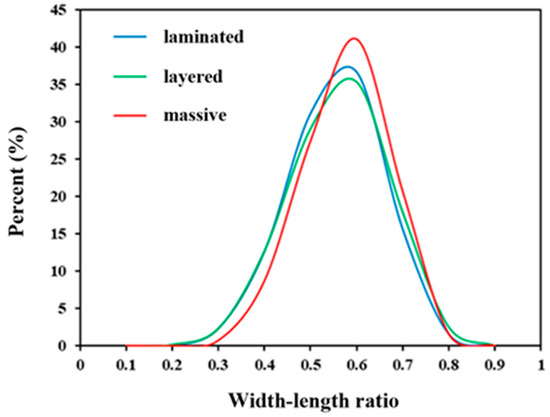
Figure 8.
The pore shape characteristics of different sedimentary structures in Gulong shale.
4. Discussion
4.1. Relationship between Pore Structure and Lithofacies
The average pore size and the sorting coefficient are two important parameters that describe the pore structure of rock. The sorting coefficient reflects the pore heterogeneity of different sizes. A low sorting coefficient means that the pores of different sizes are evenly distributed in the space, while a high sorting coefficient indicates that the distribution of pores of different sizes in space has strong heterogeneity. Based on the HPMI experiment, the average pore size and sorting coefficient of different lithofacies in the study area were calculated. Figure 9 shows the average pore size and sorting coefficient characteristics of different lithofacies in the study area, and the samples in Figure 9 correspond to the samples in Figure 7.
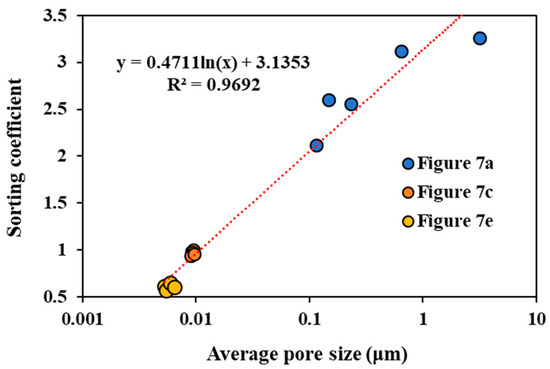
Figure 9.
Relationship between average pore size and sorting coefficient for different lithofacies in the study area.
As shown in Figure 9, with the increase in the average pore size, the corresponding sorting coefficient increases. According to Figure 7 and Figure 9, the laminated dolomitic shale facies, layered dolomitic shale facies, laminated felsic shale facies, layered felsic shale facies, and massive felsic shale facies have large average pore sizes. The massive felsic shale facies, massive dolomitic shale facies, laminated clayey shale facies, layered clayey shale facies, and layered ostracod limestone facies have a median pore size distribution. In contrast, the average pore sizes of the laminated ostracod limestone facies, layered ostracod limestone facies, massive ostracod limestone facies, and massive clayey shale facies are the smallest.
The larger the average pore size, the better the pore-to-throat connectivity. For the lithofacies in the study area, the pore distribution with a small average pore size is relatively concentrated, so the corresponding pore structure is poor, and the pore-to-throat connectivity is not good. The pore distribution with a large average pore size is relatively dispersed, which leads to part of the pore space allowing fluid to flow freely, and the pore-to-throat connectivity is relatively good. Therefore, the lithofacies type of the study area has a strong control effect on its pore structure. On the whole, the pore structures of the laminated dolomitic shale facies, layered dolomitic shale facies, laminated felsic shale facies, layered felsic shale facies, and massive felsic shale facies are good; the massive felsic shale facies, massive dolomitic shale facies, laminated clayey shale facies, layered clayey shale facies, and layered ostracod limestone facies have general pore structures; the pore structures of the laminated ostracod limestone facies, layered ostracod limestone facies, massive ostracod limestone facies, and massive clayey shale facies are the worst.
4.2. Influences of Lithofacies on Physical Properties
The difference in K2qn shale lithofacies reflects the combination of reservoir lithology and structure, so the influence on reservoir physical properties should be mainly considered based on the lithology and structural model. As shown in Figure 10, sample points with a permeability greater than 0.1 mD are generally distributed in areas with high quartz + feldspar mineral content, and sample points with a permeability less than 0.1 mD are generally distributed in areas with relatively high calcite content. Meanwhile, the higher the clay mineral content is, the physical properties of the region are generally homogeneous (Figure 10). Therefore, lithofacies dominated by quartz and feldspar minerals in the study area generally have large porosity and permeability, while rocks dominated by clay minerals have relatively weak increases in porosity and permeability. Meanwhile, lithofacies dominated by carbonate minerals are generally not conducive to the increase in porosity and permeability. The difference in the mineral content in the target layer in the study area leads to a difference in pore throat characteristics, so the lithofacies of different lithology have different effects on the physical properties only because of the difference in pore throat characteristics.

Figure 10.
Relationship between minerals and physical properties of Gulong shale.
The sedimentary structure of lithofacies in the study area is caused by the changes in mineral types and contents in space, and in essence and because of the pore micro-changes caused by different lithologies. The influence of the sedimentary structure of lithofacies on physical properties is weaker than that of lithology. Therefore, the influence of rock relative to the reservoir’s physical properties is mainly based on the difference in lithology and is supplemented by the difference in the structural model. However, it should be noted that some specific sedimentary structures in the lithofacies, such as lamination, are not conducive to the increase in permeability under certain diagenetic or tectonic conditions. K2qn shale is a semi-deep lacustrine deposit with a weak terrigenous debris supply and a low amount of brittle minerals such as calcite, but it can also form bedding fractures along the bedding plane under geological processes such as compaction and pressure dissolution. In addition, the Songliao Basin is a typical fault–depression composite basin, which was influenced by expansion and compression during its formation. The sedimentary period of K2qn shale is in the depression period of the basin, which belongs to the heat settlement stage of the Late Cretaceous [8,15,17,18]. The lake level rose rapidly, causing the center of the lake basin to become an environment of strong reduction and a stable water body, which is conducive to the formation of large-area mud shale, and the bedding fractures between sheet clay minerals are distorted and deformed under the action of tectonic stress. The pore throat connectivity is reduced to some extent (Figure 11).
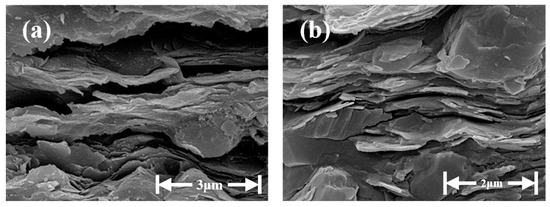
Figure 11.
Microscopic characteristics of clay mineral lamination of Gulong shale. ((a) bedding fractures between sheet clay minerals; (b) bedding fractures between sheet clay minerals).
In general, the impact of the relative physical properties of K2qn shale is essentially caused by changes in the sedimentary environment, and the difference in the physical properties of different types of lithofacies is directly related to the sedimentary environment during the formation of lithofacies. The felsic lithofacies in the study area are mostly formed in the shoreline shallow lake environment close to the source area [8,17,18], and the deposition rate is fast. Under the frequent change in the lake plane, the thickness and physical properties of felsic laminae are easy to increase. Clayey shale facies are basically developed in a semi-deep lake sedimentary environment with low energy and still water, and the sedimentary structure is mainly layered and laminated, and the minerals are mainly a micrite structure. Thus, when the clayey shale lithofacies formed, their permeability and porosity were low. However, the laminated clay mineral interlayer fractures formed in the later diagenetic process can improve the physical properties. The ostracod limestone lithofacies sedimentary area is usually located in the still water environment under the wave base in the lake basin, belonging to the shallow carbonate rock ring near the normal wave base to the mean low tide line. The water energy in this sedimentary environment is low, and since the small influence of the wave movement, water flow, and sediment flow is slow, the ostracod limestone can be formed here [15,17,19,20]. The calcite minerals are mainly a micrite structure. Due to the lack of stratification and exposure modification, the physical properties of ostracod limestone lithofacies are generally the lowest in this environment. The dolomitic lithofacies usually develop above the normal wave base in the lake basin. Its environmental hydrodynamic conditions are strong, and the wave disturbance is relatively developed. If the top is reformed by atmospheric fresh water, the reservoir physical properties can be effectively increased, and the physical properties are superior to those of the ostracod limestone lithofacies.
5. Conclusions
- Quartz and plagioclase are the main minerals in the K2qn shale, followed by clay minerals, and the lithology is dominated by felsic shale and clayey shale, with a small amount of dolomitic shale and ostracod limestone. The development frequency of laminated and layered sedimentary structures is high, while that of massive sedimentary structures is generally low. Based on the integration of the lithology and sedimentary structure, the lithofacies can be divided into 12 types.
- The relative physical properties of K2qn shale are mainly influenced by lithology differences, supplemented by sedimentary structure differences, and the difference in mineral content leads to the difference in pore structure characteristics. The larger the average pore size of the K2qn lithofacies, the better the pore-to-throat connectivity. The felsic lithofacies has good porosity and permeability, and the porosity and permeability of clayey and dolomitic lithofacies are normal, while the ostracod limestone lithofacies has poor porosity and permeability.
- In essence, the influence of rock relative reservoir physical properties is directly related to the sedimentary environment. The lithofacies in the felsic and carbonate shallow environment are conducive to the development of high physical reservoirs. The clayey shale lithofacies in the semi-deep lake sedimentary environment with low static water energy have improved their basic physical properties to a certain extent due to the development of laminae. The sedimentary period consists of the shell limestone shale lithofacies in the still water environment under the wave base of the lake basin, and its physical properties are generally poor.
Author Contributions
Methodology, Z.H., G.W., H.W. (Hongliang Wu), Z.F., H.T., Y.X. and H.W. (Hao Wu); Formal analysis, Z.H.; Resources, G.W. and H.W. (Hao Wu); Data curation, H.W. (Hongliang Wu), Z.F., H.T. and Y.X.; Writing—original draft, Z.H.; Writing—review & editing, Z.H.; Funding acquisition, G.W. and H.W. (Hao Wu). All authors have read and agreed to the published version of the manuscript.
Funding
This work was financially supported by the project funded by the research on logging characterization technology of Gulong shale oil (No. 021ZZ10-01), the national natural science foundation of China (No. 41872133), and the fundamental research funds for the central universities (No. lzujbky-2023-02).
Data Availability Statement
Data are contained within the article.
Conflicts of Interest
Author Hongliang Wu, Zhou Feng, Han Tian were employed by the company PetroChina. Author Yingyi Xie was employed by the company Exploration and Development Research Institute of Daqing Oilfield Co., Ltd. The remaining authors declare that the research was conducted in the absence of any commercial or financial relationships that could be construed as a potential conflict of interest.
References
- Liu, B.; Shi, J.; Fu, X.; Lyu, Y.; Sun, X.; Gong, L.; Bai, Y. Petrological characteristics and shale oil enrichment of lacustrine fine- grained sedimentary system: A case study of organic-rich shale in first member of Cretaceous Qingshankou Formation in Gulong Sag, Songliao Basin, NE China. Pet. Explor. Dev. 2018, 45, 884–894. [Google Scholar] [CrossRef]
- Li, M.W.; Ma, X.X.; Jin, Z.J.; Li, Z.M.; Jiang, Q.G.; Wu, S.Q.; Li, Z.; Xu, Z. Diversity in the lithofacies assemblages of marine and lacustrine shale strata and significance for uncon-ventional petroleum exploration in China. Oil Gas Geol. 2022, 43, 1–25. [Google Scholar]
- Zhang, Y.; Pan, H.; Bai, Y.; Chen, G.; Luo, J.; Zhang, Y. Pore Characteristics, Oil Contents and Factors Influencing Laminated Shale in the First Member of the Qingshankou Formation in the Gulong Sag, Northern Songliao Basin. Minerals 2023, 13, 1220. [Google Scholar] [CrossRef]
- Zhao, D.; Zhang, J.; Guan, X.; Liu, D.; Wang, Q.; Jiao, W.; Zhou, X.; Li, Y.; Wang, G.; Guo, Y. Comparing the Pore Networks of Coal, Shale, and Tight Sandstone Reservoirs of Shanxi Formation, Qinshui Basin: Inspirations for Multi-Superimposed Gas Systems in Coal-Bearing Strata. Appl. Sci. 2023, 13, 4414. [Google Scholar] [CrossRef]
- Zhao, D.; Yin, S.; Guo, Y.; Ren, C.; Wang, R.; Dinge, W.; Liue, J. Investigation of pore structure characteristics of marine organic-rich shales using low-pressure N2 adsorption experiments and fractal theory. Interpretation 2019, 7, 671–685. [Google Scholar] [CrossRef]
- Knapp, L.J.; Ardakani, O.H.; Uchida, S.; Nanjo, T.; Otomo, C.; Hattori, T. The influence of rigid matrix minerals on organic porosity and pore size in shale reservoirs: Upper Devonian Duvernay Formation, Alberta, Canada. Int. J. Coal Geol. 2020, 227, 103525. [Google Scholar] [CrossRef]
- Huang, Y.; Wang, G.; Zhang, Y.; Xi, J.; Huang, L.; Wang, S.; Zhang, Y.; Lai, J.; Jiang, C. Logging evaluation of pore structure and reservoir quality in shale oil reservoir: The Fengcheng Formation in Mahu Sag, Junggar Basin, China. Mar. Pet. Geol. 2023, 156, 106454. [Google Scholar] [CrossRef]
- Xu, H.M.; Wang, F.; Tian, J.C.; Ren, Z.C.; Meng, H.; Yu, W.; Wu, J.Y.; Xiao, Y.X. Classification of Lacustrine Organic-Rich Mud Shale Petrography and the Depositional Environment: An Example from the Chang 73 Sub-member in the Ordos Basin. Acta Sedimentol. Sin. 2023, 67, 1–24. [Google Scholar]
- Zhu, H.H.; Zhu, G.Y.; Zhang, H.Y.; Wang, M.L.; Zhang, B.J.; Hong, H.T.; Zhang, R.; Qin, C.Y.; Li, Y.C.; Li, Y.Z. Lithofacies Characteristics and Shale Oil Source and Reservoir Evaluation of Lower Jurassic Da’anzhai Member in the Northeast Sichuan Basin: Case Study from Tieshan Jinwo and Liangping Fuluzhen. Acta Sedimentol. Sin. 2023, 63, 1–17. [Google Scholar]
- He, X.B.; Luo, Q.; Li, X.; Li, Y.Y.; Deng, Y.; Qiu, Z.X.; Wei, B. Characteristics of Pore Differences Between Different Lithofacies of Continental Mixed Shale and the Influencing Mechanism: An Example from the Permian Lucaogou Formation in the Jimusar Depression. J. China Univ. Min. Technol. 2023, 125, 13247. [Google Scholar]
- Dai, Q.; Wang, G.; Zhao, X.; Han, Z.; Lu, K.; Lai, J.; Wang, S.; Li, D.; Li, Y.; Wu, K. Fractal model for permeability estimation in low-permeable porous media with variable pore sizes and unevenly adsorbed water lay. Mar. Pet. Geol. 2021, 130, 105135. [Google Scholar] [CrossRef]
- Hu, T.; Pang, X.; Jiang, F.; Wang, Q.; Liu, X.; Wang, Z.; Jiang, S.; Wu, G.; Li, C.; Xu, T.; et al. Movable oil content evaluation of lacustrine organic-rich shales: Methods and a novel quantitative evaluation model. Earth-Sci. Rev. 2021, 214, 103545. [Google Scholar] [CrossRef]
- Qiu, Z.; Tao, H.; Zou, C.; Wang, H.; Ji, H.; Zhou, S. Lithofacies and organic geochemistry of the Middle Permian Lucaogou Formation in the Jimusar Sag of the Junggar Basin, NW China. J. Pet. Sci. Eng. 2016, 140, 97–107. [Google Scholar] [CrossRef]
- Baruch, E.T.; Kennedy, M.J.; Löhr, S.C.; Dewhurst, D.N. Feldspar dissolution-enhanced porosity in Paleoproterozoic shale reservoir facies from the Barney Creek Formation (McArthur Basin, Australia). AAPG Bull. 2015, 99, 1745–1770. [Google Scholar] [CrossRef]
- Dai, Q.Q.; Luo, Q.; Zhang, C.; Lu, C.J.; Zhang, Y.Z.; Lu, S.J.; Zhao, Y. Pore structure characteristics of tight-oil sanfstone reservoir based on a new parameter measured by NMR experiment: A case study seventh Member in Yanchang Formation, Ordos Basin. Acta Pet. Sin. 2016, 37, 887–897. [Google Scholar]
- Wu, S.; Zhai, X.; Yang, Z.; Bale, H.; Hong, Y.; Cui, J.; Pan, S.; Lin, S. Characterization of fracture formation in organic-rich shales—An experimental and real time study of the Permian Lucaogou Formation, Junggar Basin, northwestern China. Mar. Pet. Geol. 2019, 107, 397–406. [Google Scholar] [CrossRef]
- Sun, L.; Tuo, J.; Zhang, M.; Wu, C.; Chai, S. Pore structures and fractal characteristics of nano-pores in shale of Lucaogou formation from Junggar Basin during water pressure-controlled artificial pyrolysis. J. Anal. Appl. Pyrolysis 2019, 140, 404–412. [Google Scholar] [CrossRef]
- Hui, W.; Wang, Y.; Ren, D.; Jin, H. Effects of pore structures on the movable fluid saturation in tight sandstones: A He8 formation example in Sulige Gasfield, Ordos Basin, China. J. Pet. Sci. Eng. 2020, 192, 107295. [Google Scholar] [CrossRef]
- Chandra, D.; Vishal, V. A critical review on pore to continuum scale imaging techniques for enhanced shale gas recovery. Earth-Sci. Rev. 2021, 217, 103638. [Google Scholar] [CrossRef]
- Dai, Q.Q.; Wang, G.W.; Lu, C.J.; Zhang, Y.Z.; Zhou, Z.L.; Fan, X.Q.; Wang, S.; He, Z.B. Occurrence characteristics and controls over mobile fluids in a tight sandstone reservoir. Aust. J. Earth Sci. 2018, 65, 877–887. [Google Scholar] [CrossRef]
Disclaimer/Publisher’s Note: The statements, opinions and data contained in all publications are solely those of the individual author(s) and contributor(s) and not of MDPI and/or the editor(s). MDPI and/or the editor(s) disclaim responsibility for any injury to people or property resulting from any ideas, methods, instructions or products referred to in the content. |
© 2024 by the authors. Licensee MDPI, Basel, Switzerland. This article is an open access article distributed under the terms and conditions of the Creative Commons Attribution (CC BY) license (https://creativecommons.org/licenses/by/4.0/).



